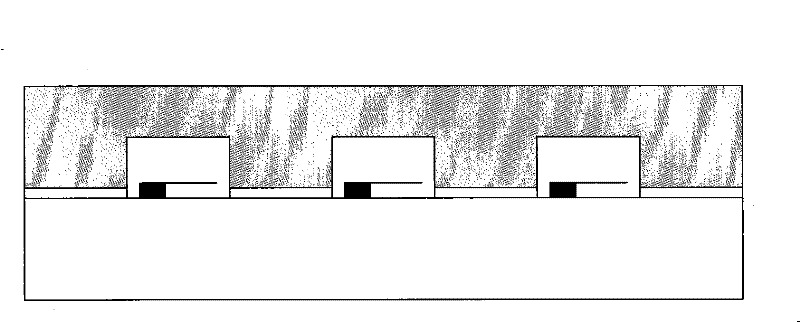Low-temperature glass solder bonding and encapsulating method based on disc level glass micro-chamber
A technology of low-temperature glass solder and packaging method, which is applied in the direction of microstructure devices, coupling of optical waveguides, processing microstructure devices, etc., can solve the problems of poor packaging reliability, large thermal mismatch, and large limitations, and reduce the Package cost, low flatness requirements, and wide application range
- Summary
- Abstract
- Description
- Claims
- Application Information
AI Technical Summary
Problems solved by technology
Method used
Image
Examples
Embodiment 1
[0026] A low-temperature glass solder bonding packaging method based on wafer-level glass microcavities, comprising the following steps:
[0027] The first step is to use the screen printing process. The screen printing technology can use precision screen printing technology to coat the low-temperature glass solder on the package contact part of the Pyrex7740 glass substrate with a microcavity structure, and then apply the low-temperature glass solder Pre-baking, the pre-baking temperature is 350 ℃ ~ 450 ℃, usually slightly higher than the glass temperature of low temperature glass solder. The low-temperature glass solder is solidified and attached to the above-mentioned Pyrex7740 glass substrate with a microcavity structure. The low-temperature glass solder used here has a glass transition temperature of 330-500°C, such as 360°C, 375°C, 400°C, 430°C, At 470°C, the coefficient of thermal expansion is (20~50)×10 -7 / K glass solder (corresponding to the thermal expansion coeffi...
Embodiment 2
[0032]A low-temperature glass solder bonding packaging method based on a wafer-level glass microcavity, the steps of the packaging method are the same as in Example 1, but the glass microcavity is prepared by the following method:
[0033] In this embodiment, the preparation method of the microcavity structure on the Pyrex7740 glass substrate is as follows: the first step is to use silicon micromachining technology to manufacture a glass microcavity pattern structure on a double-sided polished silicon wafer; The wafer and the Pyrex7740 glass wafer of the same size are bonded under a pressure of less than 1Pa, so that the glass microcavity pattern structure is sealed into a vacuum cavity. The third step is to heat the above-mentioned bonded wafer under an atmospheric pressure to 810°C-890°C, such as 830°C, 850°C, 870°C, keep warm for 3-5 minutes, the time can be selected as 4 minutes, the pressure difference between the inside and outside of the cavity makes the softened glass f...
Embodiment 3
[0035] A method for low-temperature glass solder bonding packaging of a novel wafer-level glass microcavity, comprising the following steps:
[0036] In the first step, the low-temperature glass solder is coated on the bonding contact part of the Pyrex7740 glass substrate with a microcavity structure by using a screen printing process.
[0037] In the second step, pre-baking is carried out near the glass transition temperature Tg of the low-temperature glass solder to volatilize the organic solvent in the solder and at the same time make the solder adhere tightly to the glass substrate.
[0038] The third step is to align the Pyrex7740 glass packaging wafer coated and cured with low-temperature glass solder with the silicon substrate containing CMOS circuits or MEMS devices, so that the microcavity structure is facing the packaged part on the substrate.
[0039] The fourth step is to complete the alignment of the two bonded sheets, which are clamped by the fixture to apply pre...
PUM
| Property | Measurement | Unit |
|---|---|---|
| height | aaaaa | aaaaa |
| glass transition temperature | aaaaa | aaaaa |
| glass transition temperature | aaaaa | aaaaa |
Abstract
Description
Claims
Application Information
 Login to View More
Login to View More - R&D
- Intellectual Property
- Life Sciences
- Materials
- Tech Scout
- Unparalleled Data Quality
- Higher Quality Content
- 60% Fewer Hallucinations
Browse by: Latest US Patents, China's latest patents, Technical Efficacy Thesaurus, Application Domain, Technology Topic, Popular Technical Reports.
© 2025 PatSnap. All rights reserved.Legal|Privacy policy|Modern Slavery Act Transparency Statement|Sitemap|About US| Contact US: help@patsnap.com



